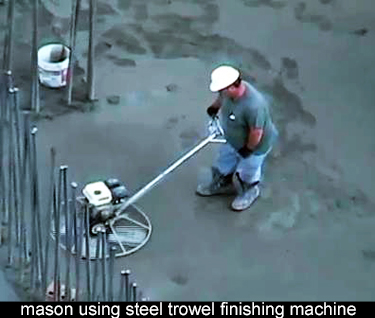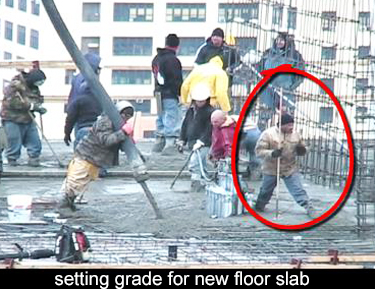Here is a day when they are pouring a floor slab, and we will have a chance to look at all of those activities. You can see a tower crane in the background. In the foreground, there's a concrete pump. They're not using the pump today. They are using a crane and bucket method. There's the concrete truck, which will fill the bucket. I think I mentioned before. A better practice is to have two buckets in place so that one can be filled while the other one is being raised up to the building.
 This mason is finishing the slab with a steel trowel. This, of course, is a mechanical steel trowel. There's also a tool call the steel trowel, which he usually carries in his back pocket. He's working very close to the edge of freshly placed concrete.
This mason is finishing the slab with a steel trowel. This, of course, is a mechanical steel trowel. There's also a tool call the steel trowel, which he usually carries in his back pocket. He's working very close to the edge of freshly placed concrete.
This concrete has been modified by adding additives, especially plasticizers, to make it much more liquid without actually increasing the water content. I have heard this described as self-leveling concrete. You will see that it is very liquid, very fluid, very easy to spread around. At the same time, it cures very quickly. This concrete has been very much modified in the laboratory, and all of that work needs to take place long before you're ready to place any concrete. It may be that you will have one mix for the floor slabs and a different mix for the columns.
Also, the columns are always poured in advance, so the columns for this floor slab have already been poured and today they're doing the deck. You see how much conduit has been distributed here. That's very time consuming work. That has to be in place before the top rebar layer, and of course, before the concrete is placed The method here is a crane and bucket. I think it's pretty obvious how flowable the concrete is. This is not a natural mix of concrete. This is a very much affected by additives.
 One man with the rake can level it out, and there are usually markers in the floor to show the laborers where the finished grade is. This fellow almost lost his boot. Over the years, I found that I would pour a slab of one sort or another and weeks later, sometimes months later, a little hole would appear, and it was always a puzzle of what, what could that be? So we would enlarge the hole to try to find out what happened more often than not you would just find somebody's boot.
One man with the rake can level it out, and there are usually markers in the floor to show the laborers where the finished grade is. This fellow almost lost his boot. Over the years, I found that I would pour a slab of one sort or another and weeks later, sometimes months later, a little hole would appear, and it was always a puzzle of what, what could that be? So we would enlarge the hole to try to find out what happened more often than not you would just find somebody's boot.
Generally, the concrete is struck off with a straight edge. You don't see evidence of that here. I think that proceeding over such a wide face that it's a little harder to control this. I suppose, on a big floor slab like this, maybe there's no other option. Although, elsewhere, I think I did capture them using a straight edge to pull down the concrete, and that would certainly be more desirable. But if you're opening up this huge face of wet concrete, they really can't do much more than they're doing here, striking it off with a rake.
That, of course, is the boom of the tower crane. That's a horizontal boom. We discussed the luffing booms, which can move up and down, this who remains in a fixed horizontal position. We'll look at the crane a little more in later part of these classes. Look at how close the mason is to the wet concrete. The concrete Begins by being very liquid, very flowable, but within a short period of time, perhaps within an hour or so, the mason can walk on it and trowel it. This is chemically controlled behavior. This is not the way natural concrete would behave.
This tool is a bull float, and the masons will strike off the concrete and level it off - take out any irregularities. You could not just rake it and call that the finished product. The bull float will even it out and then the mason will complete the finishing with the rotary steel trowel.
I'm zooming in here on these activities. These Carpenters are building a bulkhead form. It's clear on this day, at least, by the end of the day, they will only get to this location. They will not be able to finish the floor in its entirety. A bulkhead is constructed to give you a nice neat edge and the concrete will only proceed to that bulkhead. Here on the right hand side of the building, this concrete was poured this morning - and already they're loading material to set up the next set of forms. That tells you how quickly this progresses and how they occupy that concrete in a matter of hours.